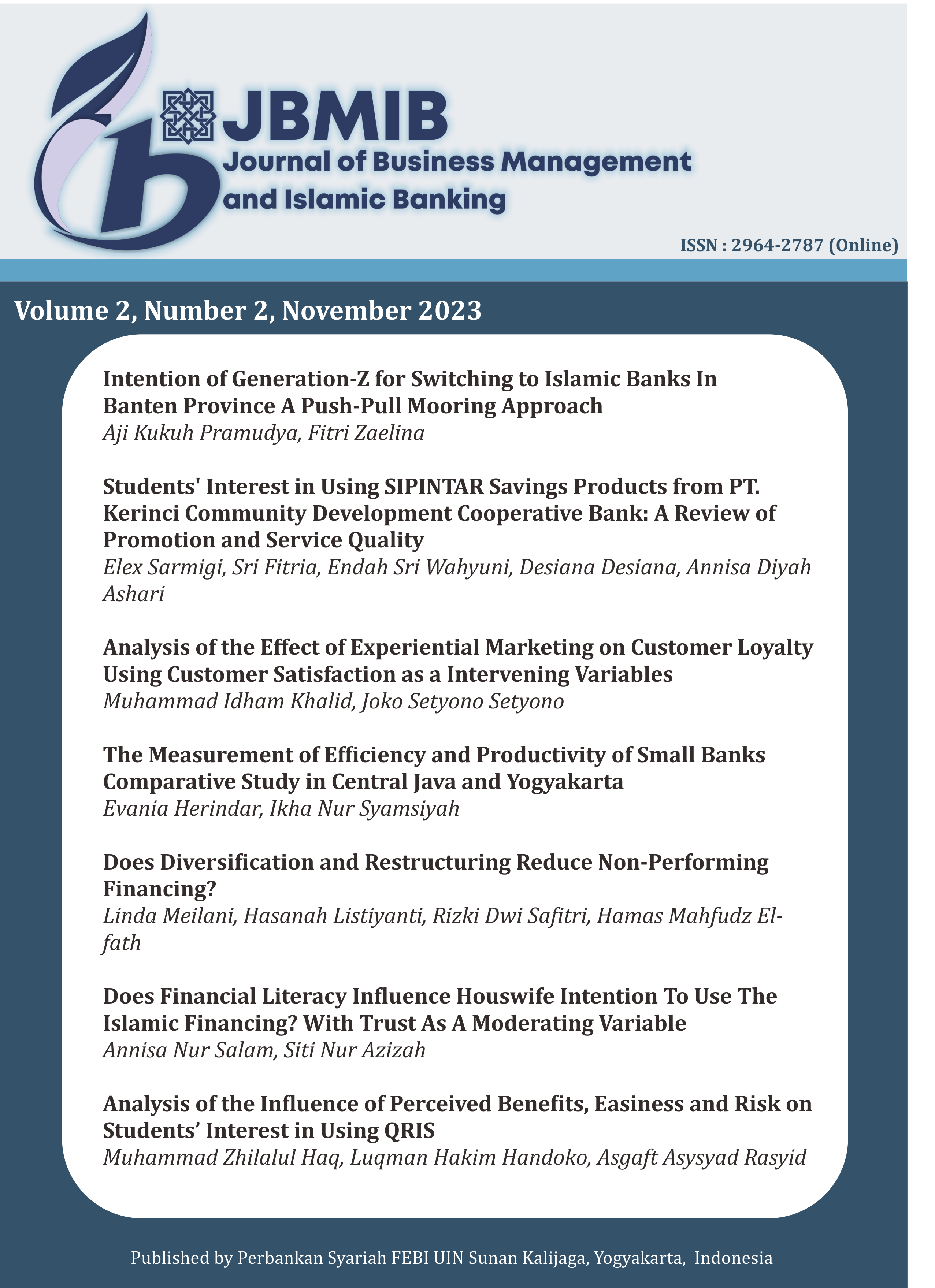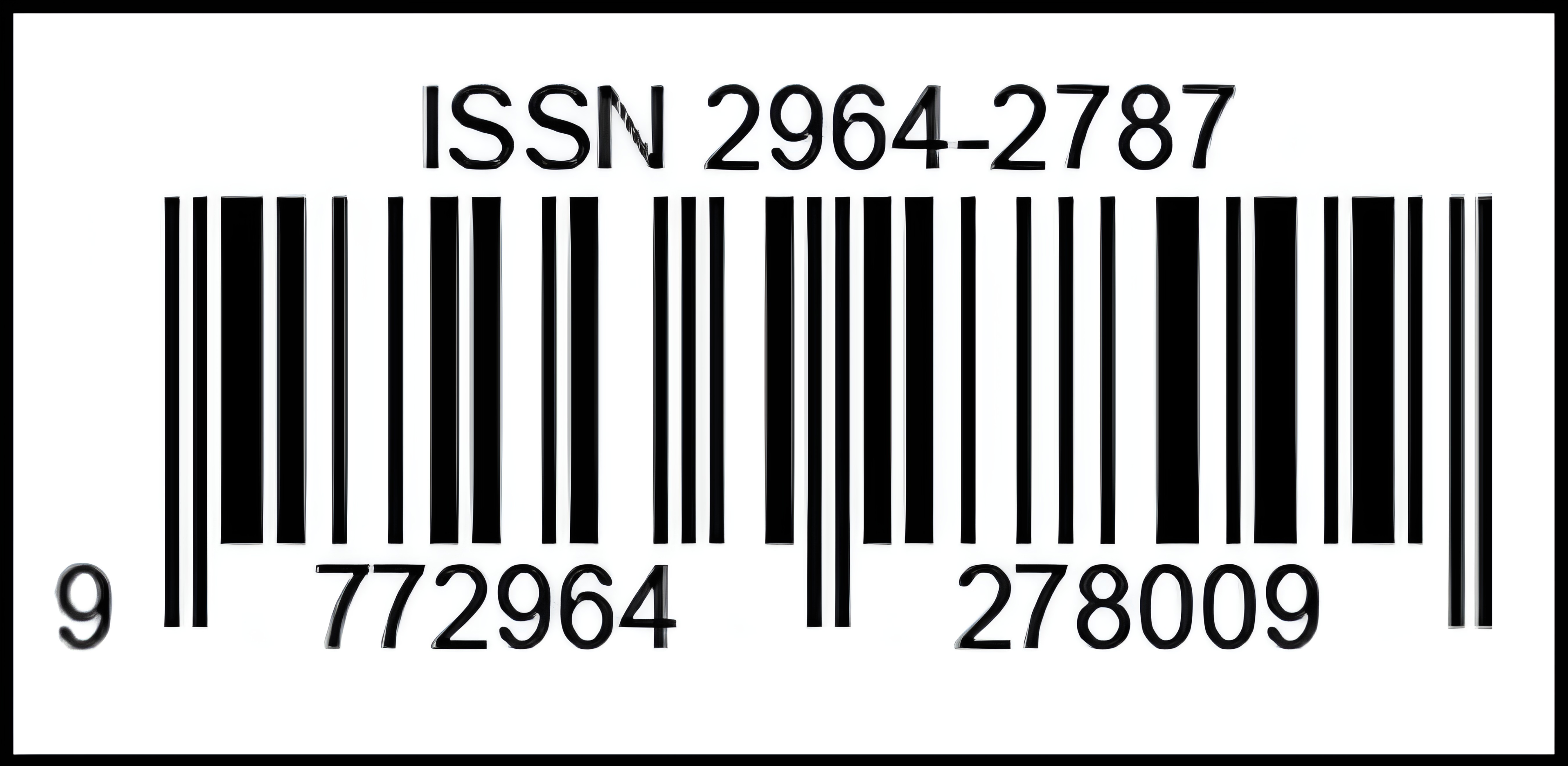Analysis of the Influence of Perceived Benefits, Easiness and Risk on Students’ Interest in Using QRIS
DOI:
https://doi.org/10.14421/jbmib.v2i2.2075Keywords:
Easiness, Percieved of Benefit, Perceived of Risks, QRIS, Students' InterestAbstract
Research Aims: This research aims to examine the influence of the perceived benefits, easiness, and risks toward students’ interest in using QRIS among STEI SEBI students.
Methodology: This type of research uses descriptive quantitative methods by collecting data through questionnaires and literature. The data obtained is then managed using the SEM-PLS (Structural Equation Modeling-Partial Least Square) tool with the SmartPLS version 4 application which goes through inner model and outer model tests.
Research Findings: The results of this study indicate that the perceived usefulness have a positive and significant effect on the intention to use QRIS, the perceived ease of use has a positive and significant effect on the intention to use QRIS, and the perceived risk has a positive and significant effect on the intention to use QRIS.
Theoretical Contribution: There have been many studies on interest in using QRIS. However, since this study focused on students’ interest will enrich and strengthen the existing theory.
Research limitation and implication: This study limited to student of STEI SEBI. Consequently, the result might be differed with others and biased. Therefore, the future research should enhance the object of study and the variables.
Downloads
 Abstract viewed: 348 times
|
Abstract viewed: 348 times
|
 PDF downloaded = 569 times
PDF downloaded = 569 times
References
Ahmad, & Pambudi, B. S. (2013). Pengaruh Persepsi Manfaat, Persepsi Kemudahan, Keamanan dan Ketersediaan Fitur Terhadap minat Ulang Nasabah Bank Dalam Menggunakan Internet Banking (Studi Pada Program Layanan Internet Banking Bri). Journal of Chemical Information and Modeling, 53(9), 1689–1699.
Aulia, N., & Suryanawa, I. ketut. (2019). Pengaruh Persepsi Kegunaan dan Kemudahan Penggunaan Pada Minat Penggunaan Quick Response Code Dalam Transaksi Keuangan. E-Jurnal Akuntansi, 28.
Azzahroo, R. A., Estiningrum, D., Kunci, K., Fintech, :, & Qris, ; (2021). Preferensi Mahasiswa dalam Menggunakan Quick Response Code Indonesia Standard (QRIS) sebagai Teknologi Pembayaran. Jurnal Manajemen Motivasi, 17(1), 10–17. https://doi.org/10.29406/JMM.V17I1.2800
Bank Indonesia. (2019a). Materi Sosialisasi QR Code Indonesian Standard (QRIS).
Bank Indonesia. (2019b). QRIS, Satu QR Code untuk Semua Pembayaran.
Chau, P. Y. K. (1996). An Empirical Assessment of a Modified Technology Acceptance Model. Journal of Management Information Systems, 13(2), 185–204. https://doi.org/10.1080/07421222.1996.11518128
Chin, W. W., & Newsted, P. R. (1998). The Partial Least Squares Approach to Structural Equation Modeling. Modern Methods for Business Research. Statistical Strategies for Small Sample Research, January 1998, 295-336.
Christy Situru, A., & Catur Putriwana Malik, M. (2023). Pengaruh Minat Penggunaan Payment Quick Response Code Indonesian Standard (QRIS) Terhadap Masyarakat di Kota Ternate. Jurnal Manarang Manajemen Dan Bisnis, 1(02), 140–148. https://doi.org/10.31605/JURNAL
Davis, F. D. (1986). A Technology Acceptance Model for Empirically Testing New End-User Infromation Systems: Theory and Result [Sloan School of Management]. In Science. https://doi.org/10.1126/science.146.3652.1648
Davis, F. D., Bagozzi, R. P., & Warshaw, P. R. (1989). User Acceptance of Computer Technology: A Comparison of Two Theoretical Models. Management Science, 35(8), 982–1003. https://doi.org/10.1287/mnsc.35.8.982
Ersaningtyas, A. P., Ety, D., & Susanti, D. (2019). Analisis Pengaruh Persepsi Kemudahan, Persepsi Resiko Dan Kualitas Informasi Terhadap Minat Menggunakan Rekening Bersama Shopee (Studi Kasus Pada Mahasiswa Fakultas Ilmu Sosial Dan Politik Universitas Pembangunan Nasional “Veteran” Jawa Timur). Jurnal Bisnis Indonesia, 10(2), 185–198.
Fadlillah, S. A., Nugroho, J. A., Sangka, K. B., Fadlillah, S. A., Nugrohoi, J. A., Sangka, K. B., Jurnal, B. :, Bisnis, Pnugrog., & Ekonomi, D. (2021). Pengaruh Kemudahan dan Keamanan Terhadap Minat Menggunakan Quick Response Code Indonesian Standard (Qris) Pada Pelaku UMKM Binaan Bank Indonesia Kpw Solo. BISE: Jurnal Pendidikan Bisnis Dan Ekonomi, 7(1), 71–83. https://doi.org/10.20961/BISE.V7I1.72989
Featherman, M. S., & Pavlou, P. A. (2003). Predicting E-services adoption: A Perceived Risk Facets Perspective. International Journal of Human Computer Studies, 59(4), 451–474. https://doi.org/10.1016/S1071-5819(03)00111-3
Gardner, C., & Amoroso, D. L. (2004). Development of An Instrument to Measure the Acceptance of internet Technology by Consumers. Proceedings of the Hawaii International Conference on System Sciences, 37(C), 4143–4152. https://doi.org/10.1109/hicss.2004.1265623
Ghozali, I. (2016). Aplikasi Analisis Multivatiete Dengan Program IBM SPSS 23. Badan Penerbit Universitas Diponegoro.
Hair, J. F., Hult, G. T. M., Ringle, C. M., & Sarstedt, M. (2017). A Primer on Partial Least Squares Structural Equation Modeling (PLS-SEM). Sage, 165.
Hill, R. J., Fishbein, M., & Ajzen, I. (1977). Belief, Attitude, Intention and Behavior: An Introduction to Theory and Research. Contemporary Sociology, 6(2), 244. https://doi.org/10.2307/2065853
Jogiyanto. (2007). Sistem informasi keperilakuan. Yogyakarta: Andi Offset.
Kotler, P., & Keller, K. L. (2016). Marketing Management (15th ed., Vol. 22). Pearson Education.
Kusuma Wardani, D., Nofita Sari, A., & Studi Akuntansi, P. (2023). Minat Penggunaan Terhadap Penggunaan Sesungguhnya Quick Response Code Indonesia Standard (Qris) Di Era New Normal. Jurnal Simki Economic, 6(1), 1–8. https://doi.org/10.29407/JSE.V6I1.145
Ningsih, H. A., M Sasmita, E., & Sari, B. (2021). Pengaruh Persepsi Manfaat, Persepsi Kemudahan Penggunaan, dan Persepsi Risiko Terhadap Keputusan Menggunakan Uang Elektronik (QRIS) pada Mahasiswa. Jurnal IKRA-ITH Ekonomika, 4(1), 1–9. https://doi.org/10.37817/IKRAITH-EKONOMIKA
Paramitha, D. A., & Kusumaningtyas, D. (2020). QRIS (D. A. S. Fauji (ed.)). Fakultas Ekonomi Universitas Nusantara PGRI Kediri.
Pavlou, P. A. (2014). Consumer Acceptance of Electronic Commerce: Integrating Trust and Risk with the Technology Acceptance Model. Http://Dx.Doi.Org/10.1080/10864415.2003.11044275, 7(3), 101–134. https://doi.org/10.1080/10864415.2003.11044275
Priambodo, S., & Prabawani, B. (2016). Pengaruh Persepsi Manfaat, Persepsi Kemudahan Penggunaan, Dan Persepsi Risiko terhadap Minat Menggunakan Layanan Uang Elektronik (Studi Kasus pada Masyarakat di Kota Semarang). Jurnal Ilmu Administrasi Bisnis, 5(2), 127–135. https://doi.org/10.14710/JIAB.2016.11294
Rahmi, S., Ilyas, G. B., Tamsah, H., & Munir, A. R. (2022). Perceived risk and its role in the influence of brand awareness on purchase intention: study of Shopee users. Jurnal Siasat Bisnis, 26(1), 97–109. https://doi.org/10.20885/jsb.vol26.iss1.art7
Ruslan, Made Karmawan, G., Suharjito, Fernandoand, Y., & Gui, A. (2019). QR Code Payment in Indonesia and Its Application on Mobile Banking. KnE Social Sciences, 2019, 551–568–551–568. https://doi.org/10.18502/KSS.V3I22.5073
Saskia, C. (2023). Modus Penipuan QRIS Palsu, Pengamat Usulkan Peningkatan Standar Keamanan Perbankan Halaman all - Kompas.com.
Seputri, W., Soemitra, A., Ahmadi, N., & Rahmani, B. (2023). Pengaruh Technolgy Acceptance Model terhadap Minat Mahasiswa Menggunakan Quick Response Code Indonesian Standard (QRIS) sebagai Cashless Society. MES Management Journal, 2(1), 116–126. https://doi.org/10.56709/MESMAN.V2I1.57
Shomad, A. C., & Purnomosidhi, B. (2012). Pengaruh Kepercayaan, Persepsi Kegunaan, Persepsi Kemudahan, dan Persepsi Risiko terhadap Perilaku Penggunaan E-commerce. Jurnal Ilmiah Mahasiswa FEB, 1(2), 1–20.
Silaen, M. F., Manurung, S., Nainggolan, C. D., Lecture, S., Tinggi, I., & Ekonomi, A. (2021). Effect Analysis of Benefit Perception, Ease Perception, Security and Risk Perception of Merchant Interest In Using Quick Response Indonesia Standard (Qris). International Journal of Science, Technology & Management, 2(5), 1574–1581. https://doi.org/10.46729/IJSTM.V2I5.313
Sugiyono. (2013). Metode Penelitian Kuantitatif, Kualitatif, dan R&D (13th ed.). ALFABETA, CV.
Ulansari, L. P. E., & Yudantara, I. G. A. P. (2021). Pengaruh Persepsi Manfaat, Persepsi Kemudahan, Persepsi Kepercayaan, dan Norma Subjektif terhadap Minat Menggunakan Sistem Informasi Pembayaran Elektronik (E-Payment). Jurnal Ilmiah Akuntansi Dan Humanika, 11(2), 312–321.
Widyananda, M. H., & Magnadi, R. H. (2018). Analisis Faktor-Faktor yang Mempengaruhi Minat Menggunakan SItus Berita Suaramerdeka.com dengan Sikap Terhadap Penggunaan sebagai Variabel Intervening. Diponegoro Journal of Management, 7(4), 1–7.
Xie, G., Zhu, J., Lu, Qi., & Suxiu, X. (2011). Influencing Factors of Consumer’s Purchasing Intention Towards Group Buying Website. IEEE International Conference on Industrial Engineering and Engineering Management, 112.
Downloads
Published
How to Cite
Issue
Section
License
Copyright (c) 2023 Journal of Business Management and Islamic Banking

This work is licensed under a Creative Commons Attribution-NonCommercial 4.0 International License.












